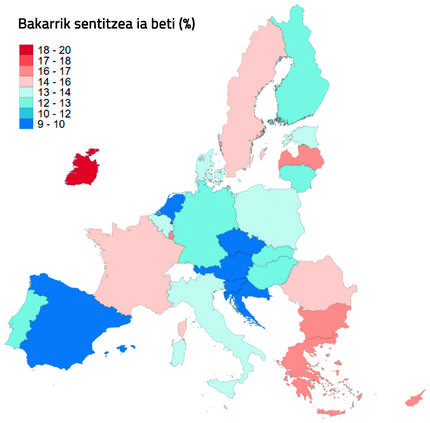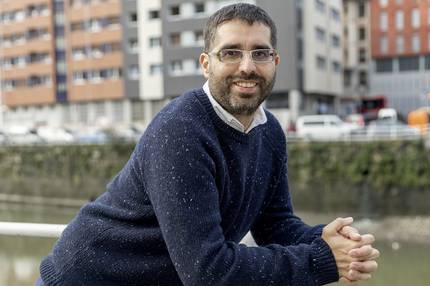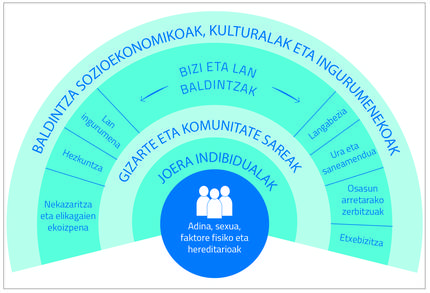When loneliness is deficient
2024/03/01 Galarraga Aiestaran, Ana - Elhuyar Zientzia Iturria: Elhuyar aldizkaria

Involuntary loneliness is a multifactorial subjective experience, but from a physical point of view, feeling can only be considered a biological alarm: as hunger drives us to seek water, loneliness leads us to relate with others. And it's not a metaphor. In November 2020, when people were isolated by the confinement of COVID-19, a significant research linking loneliness to hunger was published in the journal Nature Neuroscience.
According to this study, acute loneliness causes in the brain an equivalent response to hunger. To reach this conclusion, the researchers started from the following question: if people are isolated, do they yearn for social interaction? To find the answer, they conducted an experiment with 40 volunteers.
To start with, they analyzed the brain of the volunteers using a magnetic resonance imaging (MRI) technique. Subsequently, two ten-hour sessions were held each. In the first session, they were denied food, they could only drink water. In the second, they were prevented from relating to others, either in person or through telephone or video.
After each session, brain activity was analyzed, especially in the area called black matter. In fact, it is one of the sources that generate dopamine, it is related to mind and desire and has important roles in retribution, learning and addictions, among others. In fact, in dependent people, activity in this area increases when the addictive substance is shown to them.
After the first session, the volunteers were shown the photos of the foods they liked and, after the second, the most rewarding social relationships. Flowers photographs were used for the control. In both cases, the researchers showed that black theme activity increased. That is, in the same way that food is hungry if human relationships are isolated, albeit with less force. So they showed that hunger and loneliness produce a similar response in the brain.
However, the experiment is very short in understanding the consequences and dimension of involuntary solitude. First, the containment period was much longer than the experiment and was not voluntary. No other effects of loneliness on the brain and body were analyzed. Finally, they investigated only the individual, regardless of the social environment. Because more and more people are experiencing unwanted loneliness, and it has become apparent that the problem is not only individual but also social. Therefore, given all this, it is currently considered a public health problem and there is a pandemic.
Feeling of loneliness in Europe
As a sign of the dimension of unwanted loneliness, the European Union has launched the pilot project Monitoring Loneliness in Europe. The objective of the project is to improve the understanding of all aspects of loneliness, including individual, social and contextual factors that favor loneliness. And it also proposes solutions to deal with it.
The first step of the project took place in 2022 with a comprehensive survey to learn about the situation and in 2023 a congress was held to present and discuss the results, better understand the situation and analyze the policies to address it.
According to the survey, 13% reported feeling lonely in most cases or always and 36% sporadically. However, there are major differences by country: the highest prevalence of the feeling of loneliness was concentrated in Ireland, Greece, Bulgaria, Luxembourg and the Netherlands, and the lowest in the Czech Republic, Croatia and Austria.
Within countries, prevalence in rural areas was higher, with income, employment and age among risk factors. For example, young people showed a higher risk, but loneliness affects all age groups, and to a greater extent low-education and unemployed. A higher risk was also observed for certain groups: migrants and the LGBTQIA+ community.
In addition, the survey showed that significant relationships and the high number of social exchanges reduce the risk of feeling lonely. On the contrary, marital separation, loss of employment and completion of studies increase some life episodes.
On the other hand, a relationship was established between loneliness and aspects such as poor health, low trust in others, weak commitment to society and the intensive use of social networks. The respondents, however, stressed that the existence of a relationship does not mean that there is a cause-effect relationship.
Unwanted loneliness and health
In fact, the OPIK research group has focused on the relationship between loneliness and health. Unai Martín Roncero, PhD in Sociology and Public Health, has explained that in his work with Celia Fernández Carro, have concluded that this relationship is bidirectional: “One of the factors related to the appearance of the feeling of loneliness is the state of health and, in turn, the feeling of loneliness is an important conditioning factor of health”.
In fact, the functional, cognitive and emotional situations of a person can be a limit for the desired personal relationships and, therefore, can contribute to the appearance of the feeling of loneliness. On the other hand, unwanted loneliness has a great influence on physical and mental health and can affect quality of life and well-being.
In this sense, Martín works to understand this relationship taking into account the structural conditions and social conditions: “Understanding the connection between health and unwanted loneliness will, on the one hand, make the problem visible and reduce stigma and, on the other, establish measures to improve the quality of life and emotional well-being of those who feel alone, such as social programs, community protection services, and strategies for participation and meaningful relationships.”
According to Martín, the first step towards understanding the interaction between health and loneliness is to overcome the biomedical perspective of health. In this sense, health is contrary to disease, that is, a person is healthy if he has no disease. Therefore, it focuses on the disease and the factors that can trigger it. Even when you take life habits into account, you understand them as personal decisions.
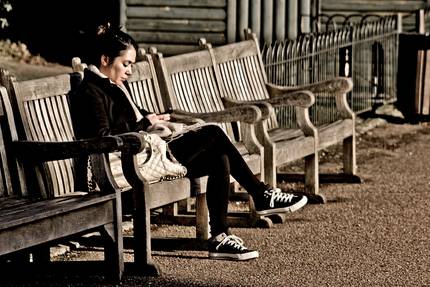
On the contrary, in the social model of health, health is not the result of a purely biological process, but also social and political. Within it, the conditions derived from the economic, political and cultural system are key to explaining both the individual health status and the health differences between social groups.
Martin sets as an example the model of researchers Dahlgren and Whitehead. They proposed a layered model. They are based on individual characteristics such as sex, age, genes, etc. In the upper layer are the habits of life. In the next, social and community protection, which includes social solitude. Above all, socio-economic, cultural and environmental conditions. These layers overlap and interact with each other.
Research results
From this point of view, he has analyzed the studies that investigate the interaction between unwanted loneliness and health. “In the last decade, more and more longitudinal investigations have been carried out that have made it possible to highlight causal relations, with a sound methodology. Thus, it has been observed that unwanted loneliness is associated with different indicators of health, morbidity and mortality”.
In the case of mortality, for example, loneliness increases the risk of all causes of death and its incidence can be assimilated to other factors such as obesity, environmental quality and physical activity.
Morbidity is closely related to cardiovascular diseases and brain emissions, as well as functional and motor problems. It also affects cognition: in Alzheimer's and dementia, the influence of loneliness can be compared with other factors known as smoking, depression and low level of education.
Other health indicators also highlight the effect of unwanted loneliness. For example, Martín himself, along with Yolanda González Rábago, published in 2021 a study with data from the Autonomous Community of the Basque Country, according to which the personal perception or conviction of having poor health is twice that of those who feel alone.
The impact on mental health is also proven: “Feeling alone is related to symptoms of depression and anxiety in all ages, sexes and socioeconomic levels,” explains Martín. And it adds a nuance: “The scientific literature clearly distinguishes the impact of social isolation on health (the network of social relations, its quality and quantity) from involuntary loneliness (the subjective perception of feeling alone). And evidence shows that both have an impact on health, both separately and jointly.”
Moreover, recent studies have shown that health effects depend to some extent on dose. Therefore, the intensity and duration of loneliness must be taken into account: the longer the loneliness remains isolated and the greater the feeling of loneliness, the more obvious the consequences are.
In the light of social constraints
Other studies have also studied life habits, and in them it is observed that the life habits of those who feel lonely are not as healthy as those of others: they consume more tobacco and alcohol, are more sedentary… To explain why Martín talks about two processes: “On the one hand, people who live alone receive less social control from family and friends and therefore have less motivation to lead a healthy life. On the other hand, they may present alterations in cognitive functions (self-regulation and correct behavior) that hinder the acquisition of healthy habits”.
Sleep quality and stress are also important intermediaries in the relationship between loneliness and health. Those who feel lonely sleep worse and less hours, largely because of the stress of loneliness. “Stress is also one of the mechanisms that best explains the relationship between loneliness and health conditions,” Martín stressed.
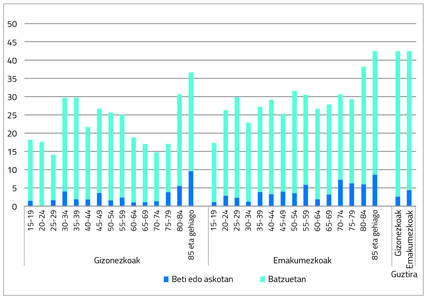
In this sense, he recalled that, in the social model of health, health depends on the living conditions: housing, employment, education…“I think this is very important. As these conditions are not shared equally in society, the health situation is not the same in all social groups. The feeling of loneliness is also divided according to the social model and, furthermore, as it affects health, it is also a cause of inequality”.
The political structures of the countries, the economic forces, the educational levels… are structural factors, and the differences between them can explain, to some extent, why there are these differences in the feeling of loneliness from one country to another. On a more micro level, Martín points out that urbanism and the distribution of green areas protect from loneliness.
Two-way relationship
The 2022 survey of living conditions in Spain shows that unwanted loneliness is more widespread among women than among men (30% more among women). It is also higher in older people than in other age groups. However, the percentage of young people who feel alone is worrying, especially because so far they have not been paid attention in solitary policies, although the need is evident.
In other places, similar results are observed, but not regarding the level of education: In the United Kingdom, as the level of education decreases, the feeling of loneliness is more widespread, while in Spain the opposite occurs.
Involuntary solitude has come out of the shadows, and proof of this is that more and more projects linked to the issue are being launched, both by governments and by smaller structures. According to Martín, the most effective are those specifically adapted to the receiver, and in this sense it is important to take into account the life cycle, since “the causes, meaning and impact of loneliness are different depending on the time of the life cycle”. It also sets an example: “It is useless to offer technological solutions in age groups with a high digital divide.”
He concludes by stressing that the relationship between health and loneliness is bidirectional and that further research and deepening is needed to preserve people's quality of life and society's health.

Gai honi buruzko eduki gehiago
Elhuyarrek garatutako teknologia



